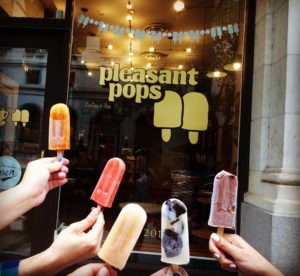
Parents pushing strollers, mothers and fathers with their kids in tow, young professionals, students, and neighborhood youth stand in line outside the Florida Avenue café in Washington, DC. Many are lured by Pleasant Pops’ trademark popsicles, which come in inventive, even exotic, flavors. Watermelon Guava Lime, Mexican Chocolate, Strawberry Ginger Lemonade are just a few of the temptations. These iced treats, modeled after the similar Mexican paleta, remind me how pedestrian the orange creamsicle of my youth was. Some are overwhelmed by the choices. Others have made up their minds. A youngster asked by his father what he wanted answered without hesitation, “Blueberry Pancake.”
The customers represent an array of nationalities—Chinese, Indian, French, Bangladeshi, Filipino. Couples often hail from different cultures. One afternoon, I struck up a conversation with two young economists who work for the World Bank. One was from Spain, the other from Kazakhstan. A woman waiting for her order of avocado toast lives across from the shop on Seaton Street and does consulting for the Labor Department. She loves her rental but fears, if she wanted to buy a house, being priced out of DC.
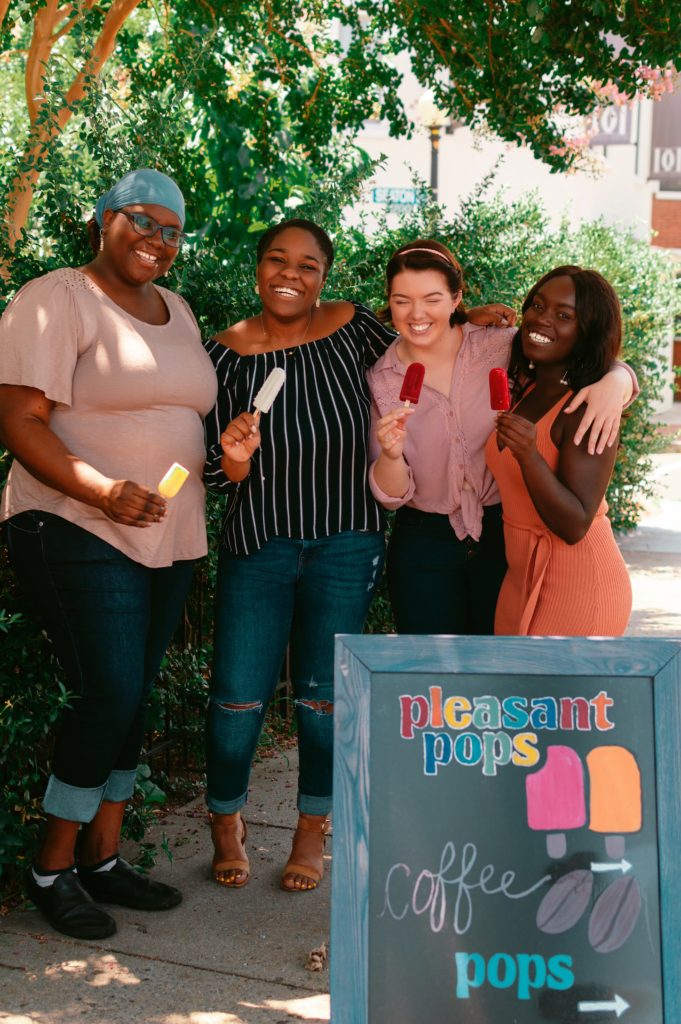
The young entrepreneurial women who own the business are a diverse lot. Employees before they became proprietors, they have already served their apprenticeship. Nadia Bartholomew, Jordan Tapley, and Afua Owusu come from multi-cultural backgrounds that are emblematic of their enterprise. Nadia’s family has roots in the Caribbean island of Aruba. Nadia, like co-owner Jordan, an African-American who grew up on Long Island, studied at Howard University. Afua’s parents are immigrants from Ghana who work in the health care field. The three are immensely proud of their achievement: A sign on the window proclaims, “100% Black-Owned Business.”
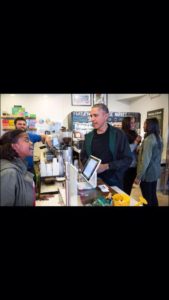
Pleasant Pops, a short walk from the intersection of 18th Street and Florida Avenue, is located in a neighborhood I only vaguely recalled from my early days in Washington in the late sixties. Two friends, fellow graduate students from Antioch, lived on Seaton Street, where the aforementioned consultant resides. I bought African dance records from a shop on Florida Avenue run by a disc jockey from Sierra Leone. The street, once off the beaten track, is more alive and is abuzz with new commerce and pedestrian traffic. A training center for the firm Counter Culture, from which Pleasant Pops buys its coffee, is next door. (A visit from President Obama and his two daughters in 2015 gave Pops cachet.)
The surrounding neighborhood has drawn a new population, many from international backgrounds, attracted by the excitement of inner city living. Another asset, parents tell me, is the proximity of the Marie Reed Elementary School, whose program is in high demand. The school sits near the home of its predecessor, the Morgan Community School. Morgan, where my Seaton Street friends taught, was run for several years as a rebellious, experimental school under the auspices of Antioch College.
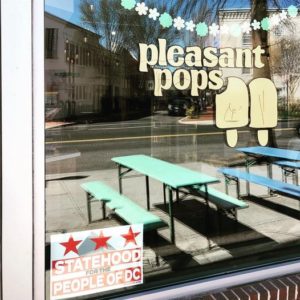
At Pleasant Pops, the owners are continually experimenting and improvising. Salads like the Naked Burrito Bowl and the Mediterranean Bowl beckon. A recent popsicle that Nadia conceived was a blend of coconut water and tropical fruits like pineapple and mango. The women have an easy familiarity with spices and herbs less common in my era. Their Golden Latte, one of a variety of specialized drinks, is flavored with turmeric and a coconut-ginger spice blend. A lemonade and a latte are redolent with cardamom, another favorite spice. A new dish on the menu provoked me to uncover its story: The piquant coconut curry soup only made sense to me when I learned a mysterious ingredient—roasted sweet potato.

Hibiscus was a favorite of the owners. Jordan, who had traveled in Mexico, recalls the “refreshing, fruity tea.” Their customers could savor hibiscus-pomegranate or hibiscus-peach popsicles and an iced tea that had the tang of lime and brilliant crimson color of the tropical flowers. For some patrons, the items were puzzling. One woman, nibbling on a hibiscus-peach popsicle, wondered how the fruit’s soft orange color could impart such a vivid hue.
She was not alone. Hibiscus is still a novelty for culinary adventurers. The variety used by Pleasant Pops is different from the ornamental flower most are familiar with. I had been exploring the flower over many years in my investigations of ethnic food. It came with different names—sorrel and karkade (prounounced kar-keh-day) are just two—and flourished in a variety of cultures, which were often unaware of its presence elsewhere. I was frequently digging up new nuggets about the plant. Here was an opportunity to reawaken my interest and to examine the twist a new generation had given it.
I started to retrace my own journey. I first encountered the hibiscus drink during my initiation into Caribbean cooking. The Islander Restaurant, a Trinidadian eatery originally on DC’s Sherman Avenue and run by the ebullient Addie Green, offered it as one of their juices, which included ginger beer and mauby, a slightly bitter drink made from the bark of a West Indian tree. Sorrel was the name given to the tart, scarlet-colored drink with a sweet edge. Its taste, West Indians felt, resembled the lemony flavor of the leaves of sorrel plants. The little knowledge I had acquired, though, gave me a false sense of certainty. The story was just beginning.
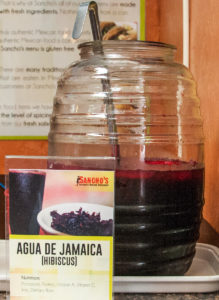
In later years, I stumbled on another piece of the puzzle. At the Tacqueria Distrito Federal in Washington’s Columbia Heights neighborhood, a cooler of jamaica (pronounced huh-mike-uh), the Mexican word for the hibiscus drink, stood on the counter, along with jugs of horchata and tamarindo. Jamaica is one of the aguas frescas, fresh waters, dear to the Mexicans. The name evoked the island where the drink was the toast of festive occasions. In Jamaica, where it was first planted in the early 18th Century, sorrel punch, fragrant with cinnamon and cloves, was essential to Christmas celebrations. Although now available year round, the plant was originally a holiday fixture because it ripened during that season.
Michelle Rousseau, co-author with her sister of a book on Caribbean food, speaks nostalgically of sorrel. “It has notes of warmth, Christmas and of being around people that you love,” she told writer Andrea Y. Henderson. Immigrants carried their fondness for hibiscus to the U.S. Street vendors sold sorrel during Christmas in New York City, historian Adrian Miller found.
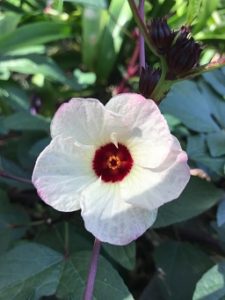
The range of hibiscus was wider than the Caribbean. It had deep ties to Africa and the Middle East. “The pharaohs used to drink it a lot,” Hassan Aziz, a counterman at the Jolt ’N Bolt coffee house in the District’s Adams Morgan neighborhood, told me. He was effusing about the glories of karkade, the Arabic word for hibiscus. The plant thrives in the blazing heat of upper Egypt, in Aswan and Luxor, the region near the border with Sudan.
When we first talked, my confidante stressed the hot hibiscus drink, not the cooler tonic I knew. He made a large glass of the steaming burgundy-colored tea. Its tart intensity was pleasing. The tea strainer bled vividly on my napkin.
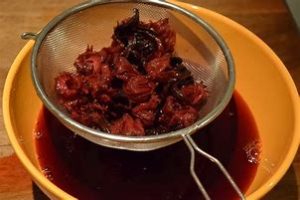
Hot tea, Hassan remarked, was an antidote to warm, sticky weather. Despite the warning of doctors against drinking iced tea in the heat, Egyptians relished chilled karkadeh on torrid days. The sociable refreshment was enjoyed in cafés and tea houses.
Hassan spun more hibiscus lore. Invoking a perhaps legendary past, he recounted how the pharaohs had used the juice of the plant to dye the walls of temples. They liked it because of karkade’s “natural color.” In Egypt today, he remarked, families lay it out in sheets on their roofs to dry, “using the sun’s rays.”
The tea was also part of holiday rituals. “In the holy month of Ramadan all the families are serving this drink to break the fast,” Hassan pointed out.
My interest whetted, I was eager to gain a more detailed understanding. From which part of the plant was the drink extracted? My informants told me variously that the flower, the bud, or the leaf was the source of the ruby-colored punch.
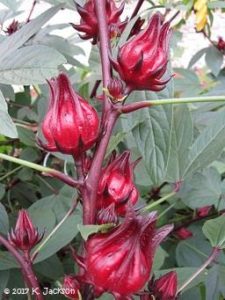
It’s actually the calyx of the plant that is used to make the hibiscus drink. The calyx is the sheath in which the flower bud is wrapped. The red calyx becomes swollen, bursting with acidic juices. After it is dried, it is steeped in hot water and sweetened for tea or cooled for an invigorating drink.
There is no definitive history of hibiscus, but there are many suggestive theories about its origin. Hibiscus sabdariffa, its technical name, is a member of a large family that includes okra and cotton. Although the plant’s birthplace may have been in Southeast Asia, it was probably first cultivated in Western Sudan, says anthropologist G.P. Murdock. Hibiscus remains a vital export in Sudan’s economy. It arrived in the Americas from Africa with the slave trade, botanist P.M. Smith argues. Hibiscus reached Brazil in the 17th Century and then Jamaica in the 18th Century.
Spain may have been also an important jumping off point for the plant. The country’s Moorish conquerors are likely to have transported it there. The Spaniards, in turn, introduced hibiscus to Europe in the 12th Century. In France, hibiscus still carries the Arabic name, karkade. Spanish colonials possibly took it from Jamaica to Mexico.
I returned to my exploration and ventured to Khartoum, an early cultural outpost for Sudanese and Arabic food on Florida Avenue, not far from Pleasant Pops’ location today. Karkade and apricot juice coursed through the luncheonette’s jet spray machines. I sipped a hibiscus drink, or Sudan tea, as it is known. It was not as sour as I would have liked. But that probably didn’t matter to Khartoum’s patrons, for whom it brought back memories of more carefree days at home.
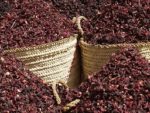
The Sudanese also prize the plant’s medicinal virtues, especially as a remedy for high blood pressure. The owner of the Khartoum Grocery, not far from the eatery, extolled his country’s “famous” product. He pulled a bag of dry calyces, a package of powdered tea, and a bottle of Scrumpy Hibiscus Tea, manufactured in Jamaica, from his shelves, crammed with Arabic wares. He touted karkade’s curative powers: “It can help with any problem in the chest. It can give you energy.” Food and drink for Mustafa were elixirs: “All of our things have two sides. One is taste. One is medicine.”
There was still another angle to this alluring flower. In conversations with West Africans, a new name for the hibiscus drink, bissap, kept popping up. It derived from the Wolof language of Senegal. A friend from the Ivory Coast, who also frequented Cosi, a coffee shop near my home, introduced it to me. Carrying containers of the drink with her, she wooed customers in the peddling tradition of her homeland. I bought a jug one day and found its tartness exhilarating.
At her recommendation, my wife, Peggy, two friends and I visited an Ivoirian eatery hidden away in suburban Langley Park. As we walked through the living room of the private home, we passed young Africans sitting watching videos. Our hostess, who had just been in New York searching for a choice guinea hen, served us a dinner of grilled chicken, fried plantains with a sauce of alloco, a fiery red chili sauce, and attiéké, a fermented grain. To cap it off, she presented us with a pitcher of bissap.
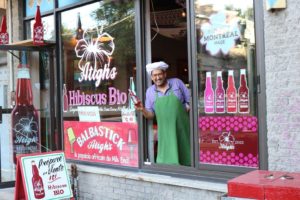
Across the border in Canada, I met an enterprising immigrant from Mauritania, who was dreaming up new ways of promoting hibiscus. Mohammed Ould Atigh designed his Montreal restaurant to convey the feel of the nomadic, desert country, which touched both West and North Africa. The ceiling was draped with pieces of cloth to look like a tent whose Arabic name, La Khaima, was the same as the restaurant’s. Low tables, cushions, and colorful North African fabrics created an exotic atmosphere. Atigh himself wore a blue turban. Harira soup, an orange-colored, peppery broth with lentils, pasta, and chickpeas, and a tagine, a Moroccan-style chicken stew accented with olives and sour lemons, were among the delicacies we savored. Bissap, a popular drink of his country, was poured from the side spout of a vase-like glass pitcher. Popsicles infused with hibiscus, Atigh commented, would be a nice supermarket item. He is now marketing both frozen hibiscus popsicles and bottling his own brand of hibiscus juices.
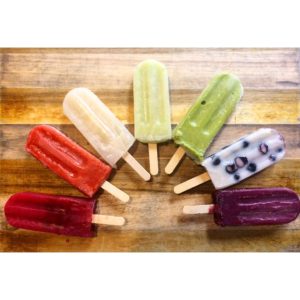
Back in Washington, the innovators at Pleasant Pops are probably conjuring up new menu ideas, perhaps tinkering with new ways of utilizing hibiscus. Maybe a hibiscus-flavored salad dressing?
Pleasant Pops, 1781 Florida Avenue, N.W., 202-558-5224







